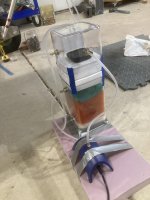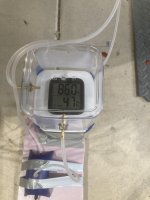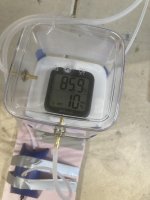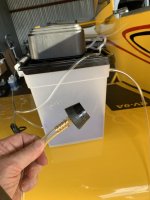Desert Rat
Well Known Member
I've got quite a bit of travel coming up and my engine has been out of the bag for going on 6 months now. Based on that, I thought it wouldn't hurt anything to throw together an engine air dehydrator as I've seen others do.
This was all made with amazon and dollar store parts and literally just thrown together with duct tape in the short time I had before leaving on a trip. Total cost was about $80, with the desiccant being the most expensive component by a large margin. I'll pretty it up with an actual base and frame at some point.
Full disclosure, I've also got desiccant plugs in the upper spark plug holes, but I've never been convinced that they really do much to help with what might be going on down in the guts of the engine.
The humidity drop after only a few minutes of operation is pretty dramatic, although I have to confess I'm a bit skeptical of any reading I get from a $10 battery powered hydrometer I got from Amazon.
I originally got fancy and had this running a few hours a day on a timer, but the humidity would come up to about 20% within a few hours of the pump shutting off. I suspect theres a good chance this is just ambient air leaking around the lid seals on the cheap dollar store food canisters, but at any rate, for now I just ditched to timer and let it's do it's thing 24/7.
The white and green stuff sandwiching the desiccant are just some scotchbrite pads that serve no purpose other than to keep the desiccant from sloshing around in there.
The plumbing pulls air from the breather tube into the gauge chamber, then into the pump, then through the desiccant chamber, then back into the dipstick tube.
Not making any claims about whether this is necessary or not, but I figure it cant hurt.
edit- in case it's not clear; picture 2 was reading ambient temp/humidity before I plugged it in. Picture 3 was about 10 minutes after flipping the switch.
This was all made with amazon and dollar store parts and literally just thrown together with duct tape in the short time I had before leaving on a trip. Total cost was about $80, with the desiccant being the most expensive component by a large margin. I'll pretty it up with an actual base and frame at some point.
Full disclosure, I've also got desiccant plugs in the upper spark plug holes, but I've never been convinced that they really do much to help with what might be going on down in the guts of the engine.
The humidity drop after only a few minutes of operation is pretty dramatic, although I have to confess I'm a bit skeptical of any reading I get from a $10 battery powered hydrometer I got from Amazon.
I originally got fancy and had this running a few hours a day on a timer, but the humidity would come up to about 20% within a few hours of the pump shutting off. I suspect theres a good chance this is just ambient air leaking around the lid seals on the cheap dollar store food canisters, but at any rate, for now I just ditched to timer and let it's do it's thing 24/7.
The white and green stuff sandwiching the desiccant are just some scotchbrite pads that serve no purpose other than to keep the desiccant from sloshing around in there.
The plumbing pulls air from the breather tube into the gauge chamber, then into the pump, then through the desiccant chamber, then back into the dipstick tube.
Not making any claims about whether this is necessary or not, but I figure it cant hurt.
edit- in case it's not clear; picture 2 was reading ambient temp/humidity before I plugged it in. Picture 3 was about 10 minutes after flipping the switch.
Attachments
Last edited:















